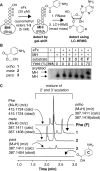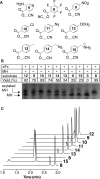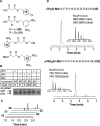Translation of Diverse Aramid- and 1,3-Dicarbonyl-peptides by Wild Type Ribosomes in Vitro
- PMID: 31403077
- PMCID: PMC6661870
- DOI: 10.1021/acscentsci.9b00460
Translation of Diverse Aramid- and 1,3-Dicarbonyl-peptides by Wild Type Ribosomes in Vitro
Abstract
Here, we report that wild type Escherichia coli ribosomes accept and elongate precharged initiator tRNAs acylated with multiple benzoic acids, including aramid precursors, as well as malonyl (1,3-dicarbonyl) substrates to generate a diverse set of aramid-peptide and polyketide-peptide hybrid molecules. This work expands the scope of ribozyme- and ribosome-catalyzed chemical transformations, provides a starting point for in vivo translation engineering efforts, and offers an alternative strategy for the biosynthesis of polyketide-peptide natural products.
Conflict of interest statement
The authors declare no competing financial interest.
Figures





Similar articles
-
Ribosome-initiator tRNA complex as an intermediate in translation initiation in Escherichia coli revealed by use of mutant initiator tRNAs and specialized ribosomes.EMBO J. 1996 Sep 2;15(17):4734-9. EMBO J. 1996. PMID: 8887564 Free PMC article.
-
The ribosome can discriminate the chirality of amino acids within its peptidyl-transferase center.Proc Natl Acad Sci U S A. 2015 May 12;112(19):6038-43. doi: 10.1073/pnas.1424712112. Epub 2015 Apr 27. Proc Natl Acad Sci U S A. 2015. PMID: 25918365 Free PMC article.
-
Ribosomal synthesis and folding of peptide-helical aromatic foldamer hybrids.Nat Chem. 2018 Apr;10(4):405-412. doi: 10.1038/s41557-018-0007-x. Epub 2018 Mar 19. Nat Chem. 2018. PMID: 29556052
-
Ribosome-mediated synthesis of natural product-like peptides via cell-free translation.Curr Opin Chem Biol. 2016 Oct;34:44-52. doi: 10.1016/j.cbpa.2016.06.006. Epub 2016 Jun 24. Curr Opin Chem Biol. 2016. PMID: 27344230 Review.
-
Engineering bacterial translation initiation - Do we have all the tools we need?Biochim Biophys Acta Gen Subj. 2017 Nov;1861(11 Pt B):3060-3069. doi: 10.1016/j.bbagen.2017.03.008. Epub 2017 Mar 14. Biochim Biophys Acta Gen Subj. 2017. PMID: 28315412 Review.
Cited by
-
Preparation of mono-substituted malonic acid half oxyesters (SMAHOs).Beilstein J Org Chem. 2021 Aug 18;17:2085-2094. doi: 10.3762/bjoc.17.135. eCollection 2021. Beilstein J Org Chem. 2021. PMID: 34476015 Free PMC article.
-
Ribosome-mediated biosynthesis of pyridazinone oligomers in vitro.Nat Commun. 2022 Oct 24;13(1):6322. doi: 10.1038/s41467-022-33701-2. Nat Commun. 2022. PMID: 36280685 Free PMC article.
-
Ribosome-mediated polymerization of long chain carbon and cyclic amino acids into peptides in vitro.Nat Commun. 2020 Aug 27;11(1):4304. doi: 10.1038/s41467-020-18001-x. Nat Commun. 2020. PMID: 32855412 Free PMC article.
-
Expanding the limits of the second genetic code with ribozymes.Nat Commun. 2019 Nov 8;10(1):5097. doi: 10.1038/s41467-019-12916-w. Nat Commun. 2019. PMID: 31704912 Free PMC article.
-
Cell-free Biosynthesis of Peptidomimetics.Biotechnol Bioprocess Eng. 2023 Feb 3:1-17. doi: 10.1007/s12257-022-0268-5. Online ahead of print. Biotechnol Bioprocess Eng. 2023. PMID: 36778039 Free PMC article. Review.
References
-
- Maini R.; Nguyen D. T.; Chen S.; Dedkova L. M.; Chowdhury S. R.; Alcala-Torano R.; Hecht S. M. Incorporation of β-amino acids into dihydrofolate reductase by ribosomes having modifications in the peptidyltransferase center. Bioorg. Med. Chem. 2013, 21, 1088–1096. 10.1016/j.bmc.2013.01.002. - DOI - PubMed
LinkOut - more resources
Full Text Sources
Other Literature Sources

